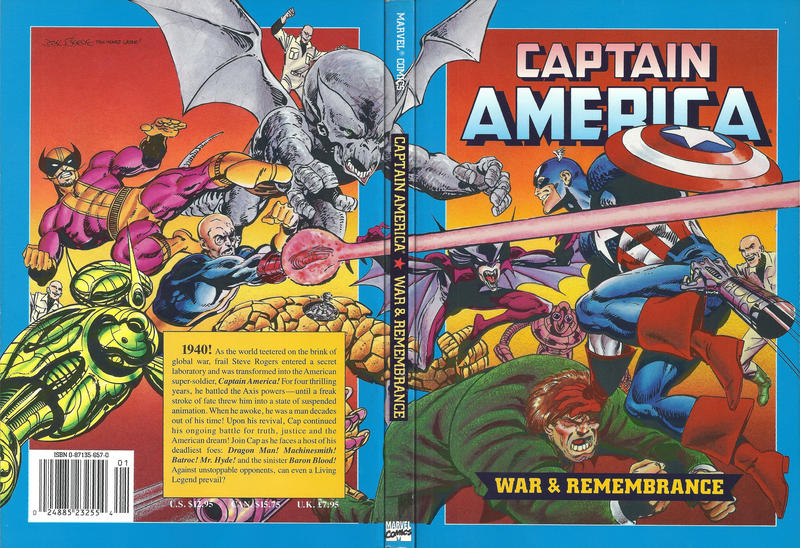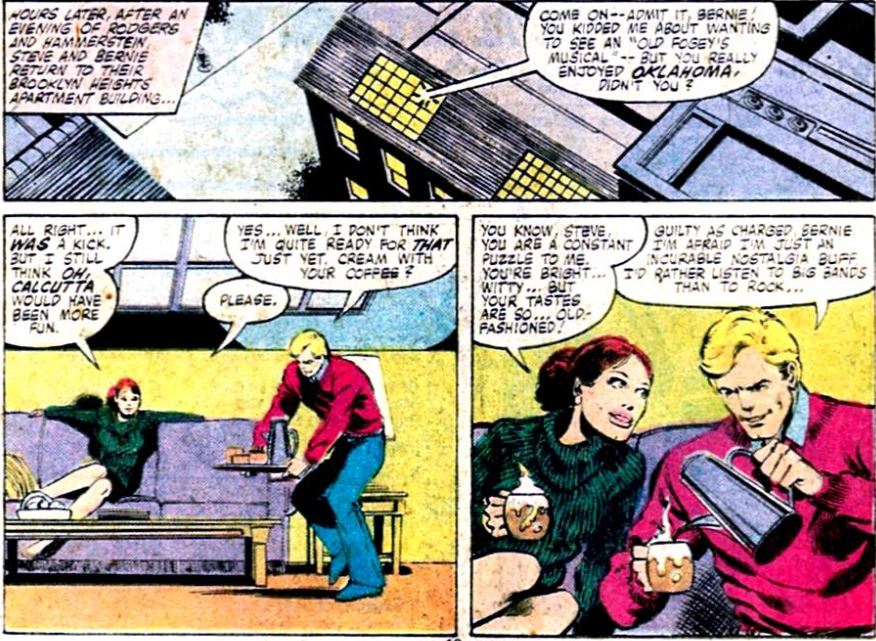You may not like it, but this is what peak Bronze Age storytelling looks like, courtesy of Roger Stern and John Byrne.

Captain America: War & Remembrance is a 1990 trade paperback collecting the short, nine issue 1980-81 run of John Byrne and Roger Stern on Captain America (#247 – #255). As such it’s a showcase of what a typical Late Bronze Age, Shooter-era Marvel comic read like. This period, roughly 1976 to 1984 and the first Secret Wars, might just be my favourite Marvel period, at least in terms of the Marvel Universe as a coherent metafiction. It’s still small enough to be comprehensible even if you didn’t follow every title, had endured long enough to have a proper sense of history while it was not yet spoiled by endless crossover events and reboots. Not quite the Marvel I grew up with (I started reading superhero comics in earnest only in 1987), but the Marvel I got to know and love through back issues and collections like this.
John Byrne at this time is still just an artist, not quite the writer-artist he would become on Fantastic Four; he and Roger Stern broke into comics together doing fan work for Charlton before both went to Marvel. Stern started work as an editor and went on to write several series, most noticably Avengers and Dr Strange. Byrne of course worked mostly with Chris Claremont on e.g. Iron Fist and Uncanny X-Men. Their short run on Captain America is the only series Stern and Byrne worked on together.
But what do I mean by calling this a showcase of Bronze Age storytelling? How is that reflected in these issues? For me it’s a combination of several things. The first is continuity, having that sense of a wider universe in which Captain America takes place. Sometimes this is done casually, as for example in issue 250, which floats the idea of Cap standing for president in the 1980 elections. Not only do we get Cap visiting the Avengers mansion and getting the responses of his team mates to the news (Wasp & the Beast are all for it, Vision and Iron Man less so), but there’s also cameos of other like superheroes like Daredevil, Spidey and Doctor Strange. Funniest is J,. Johan Jameson’s reaction: conflicted until Joe Robinson teases him with “Spider-Man for mayor”. Ultimately of course Cap decides not to run, which is pity considering who would win that year.
The concern for continuity is also shown in the first story in this volume, from issue 247, in which Cap’s wartime footlocker is found and Stern takes the time to fix the mess a previous writer (Steve Gerber) had made of Cap’s origin. Gerber had him the son of a Maryland diplomat with an elder brother who died at Pearl Harbour, rather than an arty Brooklyn kid that Simon & Kirby had made him. Stern resolves it by making Gerber’s version an implanted memory as protection against Nazi torture revealing his true identity. At the same time Stern also re-introduces old Nick Fury foe Baron von Strucker, who was supposed to have died in Strange tales 168 but then showed up in Captain America 130/131 without explanation. At the end of the issue it turns out Strucker is an android.
Which brings me to the next characteristic of Bronze Age storytelling. The story in issue 247 ends with the destruction of the von Strucker android and the revelation of a new villain, Machinesmith. In the next issue he sends an old Fantastic Four foe, the Dragon Man, another android, to attack Captain America, ending on a cliffhanger with Cap in danger of being squeezed to death by the giant android. Then in issue 248 Cap escapes and follows Dragon Man back to Machinesmith’s lair, where he’s attacked by all sorts of half finished replicas of various heroes and villains. In the end it’s all an elaborate ruse to get Cap to kill him, being unable to commit suicide himself. A story that flows naturally through those three issues, but each part of which stands on its own, is a satisfying read in its own right. And while this story is being told, we also get a few look-ins at what Cap’s supporting cast is doing, especially a potential new love interest called Bernie Rosenthal who will stick around for a fair few years.
The other two stories, from issue 251-252 and 253-254 are similar in the way they operate as part of a wider universe. The first had Mister Hyde escaping from prison with the help of Batroc ze Leaper, hijack an LNG tanker to hold for ransom, then wanting to steer it into Manhattan anyway just to kill his old partner, the Cobra. That leads to Batroc teaming up with Cap to stop Hyde, exactly what you would expect of a ‘noble villain” like him. The first part of this story has Cap meeting with D. A. Tower, who would pop up in a lot of New York set Marvel titles. It’s that sort of detail that makes the Bronze Age MU feel so real and lived in. The last story Stern and Byrne did for Captain America has him go to England to meet an old friend and fight an old foe. Spitfire was a young girl during World War II fighting alongside Cap in The Invaders; she’s now a middle aged woman. the Marvel Universe at that time hadn’t quite settled for a floating timeline yet, so this sort of thing could still happen.

The last bit of Bronze Age storytelling I wanted to highlight comes from this final story, issue 253, which has Cap go on a date with Bernie to see Oklahoma and this half page neatly shows off how superheroes once upon a time had a private life away from the costume, not being stuck in Avengers Towers with the rest of the freaks. It also shows just how much sheer dialogue and captions were used back then. These are seventeen and twenty two page stories but they take longer to read than some modern paperbacks collecting six issues…
No Comments